Tantalum(IV) sulfide
Tantalum(IV) sulfide is an inorganic compound with the formula TaS2. It is a layered compound with three-coordinate sulfide centres and trigonal prismatic or octahedral metal centres.[2] It is structurally similar to molybdenum disulfide MoS2, and numerous other transition metal dichalcogenide materials. The 1T-TaS2 polytype exhibits some unusual properties. In common with many other transition metal dichalcogenide (TMD) compounds, which are metallic at high temperatures, it exhibits a series of charge-density-wave (CDW) phase transitions from 550 K to 50 K. It is unusual amongst them in showing a low-temperature insulating state below 200 K, which is believed to arise from electron correlations, similar to many oxides. The insulating state is commonly attributed to a Mott state.[3] It is also superconducting under pressure or upon doping, with a familiar dome-like phase diagram as a function of dopant, or substituted isovalent element concentration.
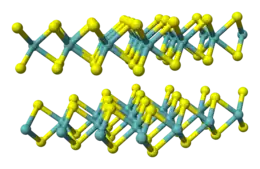 Crystal structure showing two stacked S-Ta-S sheets | |
| Names | |
|---|---|
| Other names
tantalum disulfide | |
| Identifiers | |
3D model (JSmol) |
|
| ECHA InfoCard | 100.032.047 |
PubChem CID |
|
CompTox Dashboard (EPA) |
|
| |
| |
| Properties | |
| TaS2 | |
| Molar mass | 245.078 g/mol[1] |
| Appearance | golden or black crystals, depending on polytype[1] |
| Density | 6.86 g/cm3[1] |
| Melting point | >3000 °C[1] |
| Insoluble[1] | |
| Related compounds | |
Other anions |
Tantalum telluride Tantalum diselenide |
Except where otherwise noted, data are given for materials in their standard state (at 25 °C [77 °F], 100 kPa).
Infobox references | |
Metastability. 1T-TaS2 is unique, not only amongst TMDs but also amongst 'quantum materials' in general, in showing a metastable metallic state at low temperatures.[4] Switching from the insulating to the metallic state can be achieved either optically or by the application of electrical pulses. The metallic state is persistent at low temperatures (below ~20K), but its lifetime can be tuned by changing the temperature. The metastable state lifetime can also be tuned by strain. The electrically-induced switching between states is of current interest, because it can be used for ultrafast energy-efficient memory devices.[5]
Because of the frustrated triangular arrangement of localized electrons, the material is suspected of supporting some form of quantum spin liquid state. It has been the subject of numerous studies as a host for intercalation of electron donors.[6]
Preparation
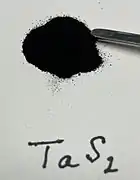 Sample polycrystalline TaS2
Sample polycrystalline TaS2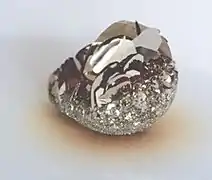 1T-TaS2 crystals grown by transport reaction
1T-TaS2 crystals grown by transport reaction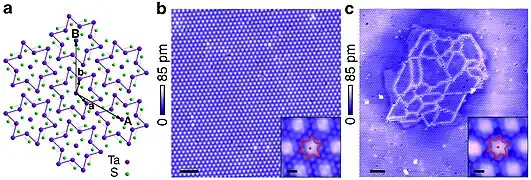 (a): Schematic of the David star pattern in 1T-TaS2 where green atoms are S and purple are Ta. (b) and (c) are STM images (6.5 K) before and after application of 2.8 V pulses through the STM tip. Insets show ~10 times magnified images.
(a): Schematic of the David star pattern in 1T-TaS2 where green atoms are S and purple are Ta. (b) and (c) are STM images (6.5 K) before and after application of 2.8 V pulses through the STM tip. Insets show ~10 times magnified images.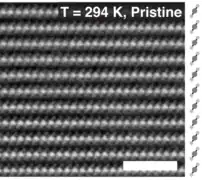 Atomic resolution image of 1T-TaS2 (298 K). Acquired using HAADF STEM. Scale bar 2nm.[7]
Atomic resolution image of 1T-TaS2 (298 K). Acquired using HAADF STEM. Scale bar 2nm.[7]
TaS2 is prepared by reaction of powdered tantalum and sulfur at ~900 °C.[8] It is purified and crystallized by chemical vapor transport using iodine as the transporting agent:[9]
- TaS2 + 2 I2 ⇌ TaI4 + 2 S
It can be easily cleaved and has a characteristic golden sheen. Upon extended exposure to air, the formation of an oxide layer causes darkening of the surface. Thin films can be prepared by chemical vapour deposition and molecular beam epitaxy.
Properties
Three major crystalline phases are known for TaS2: trigonal 1T with one S-Ta-S sheet per unit cell, hexagonal 2H with two S-Ta-S sheets, and rhombohedral 3R with three S-Ta-S sheets per cell; 4H and 6R phases are also observed, but less frequently. These polymorphs mostly differ by the relative arrangement of the S-Ta-S sheet rather than the sheet structure.[10]
2H-TaS2 is a superconductor with the bulk transition temperature TC = 0.5 K, which increases to 2.2 K in flakes with a thickness of a few atomic layers.[8] The bulk TC value increases up to ~8 K at 10 GPa and then saturates with increasing pressure.[11] In contrast, 1T-TaS2 starts superconducting only at ~2 GPa; as a function of pressure its TC quickly rises up to 5 K at ~4 GPa and then saturates.[3]
At ambient pressure and low temperatures 1T-TaS2 is a Mott insulator.[3] Upon heating it changes to a Triclinic charge density wave (TCDW) state at TTCDW ~ 220 K,[12][13][14] to a nearly commensurate charge density wave (NCCDW) state at TNCCDW ~ 280 K,[2] to an incommensurate CDW (ICCDW) state at TICCDW ~ 350 K,[2] and to a metallic state at TM ~ 600 K.[7]
In the CDW state the TaS2 lattice deforms to create a periodic Star of David pattern. Application of (e.g. 50fs) optical laser pulses[4] or voltage pulses (~2–3 V) through electrodes[15] or in a scanning tunneling microscope (STM) to the CDW state causes it to drop electrical resistance and creates a "mosaic" or domain state consisting of nanometer-sized domains, where both the domains and their walls exhibit metallic conductivity. This mosaic structure is metastable and gradually disappears upon heating.[9][16][15]
Memory devices and other potential applications
Switching of the material to and from the "mosaic", or domain state, by optical or electrical pulses is used for "Charge configuration memory" (CCM) devices. The distinguishing feature of such devices is that they exhibit very efficient and fast non-thermal resistance switching at low temperatures.[5] Room temperature operation of a charge-density-wave oscillator and thermally-driven GHz modulation of the CDW state have been demonstrated.[17][18]
References
- Haynes, William M., ed. (2011). CRC Handbook of Chemistry and Physics (92nd ed.). Boca Raton, FL: CRC Press. p. 4.93. ISBN 1-4398-5511-0.
- Wilson, J.A.; Di Salvo, F.J.; Mahajan, S. (1975). "Charge-density waves and superlattices in the metallic layered transition metal dichalcogenides". Advances in Physics. 24 (2): 117–201. doi:10.1080/00018737500101391.
- Sipos, B.; Kusmartseva, A. F.; Akrap, A.; Berger, H.; Forró, L.; Tutiš, E. (2008). "From Mott state to superconductivity in 1T-TaS2". Nature Materials. 7 (12): 960–5. Bibcode:2008NatMa...7..960S. doi:10.1038/nmat2318. PMID 18997775. S2CID 205402097.
- Stojchevska, L.; Vaskivskyi, I.; Mertelj, T.; Kusar, P.; Svetin, D.; Brazovskii, S.; Mihailovic, D. (2014). "Ultrafast Switching to a Stable Hidden Quantum State in an Electronic Crystal". Science. 344 (6180): 177–180. arXiv:1401.6786. Bibcode:2014Sci...344..177S. doi:10.1126/science.1241591. ISSN 0036-8075. PMID 24723607. S2CID 206550327.
- Mihailovic, D.; Svetin, D.; Vaskivskyi, I.; Venturini, R.; Lipovsek, B.; Mraz, A. (2021). "Ultrafast non-thermal and thermal switching in charge configuration memory devices based on 1T-TaS2". Appl. Phys. Lett. 119 (1): 013106. Bibcode:2021ApPhL.119a3106M. doi:10.1063/5.0052311. S2CID 237851661.
- Revelli, J. F.; Disalvo, F. J. (1995). "Tantalum Disulfide (TaS2 ) and Its Intercalation Compounds". Tantalum Disulfide (TaS2) and Its Intercalation Compounds. Inorganic Syntheses. Vol. 30. pp. 155–169. doi:10.1002/9780470132616.ch32. ISBN 9780470132616.
- Sung, S.; Schnitzer, N.; Novak, S.; Kourkoutis, L.; Heron, J.; Hovden, R. (2022). "Two-dimensional charge order stabilized in clean polytype heterostructures". Nat. Commun. 13 (1): 413. Bibcode:2022NatCo..13..413S. doi:10.1038/s41467-021-27947-5. PMC 8776735. PMID 35058434.
- Navarro-Moratalla, Efrén; Island, Joshua O.; Mañas-Valero, Samuel; Pinilla-Cienfuegos, Elena; Castellanos-Gomez, Andres; Quereda, Jorge; Rubio-Bollinger, Gabino; Chirolli, Luca; Silva-Guillén, Jose Angel; Agraït, Nicolás; Steele, Gary A.; Guinea, Francisco; Van Der Zant, Herre S. J.; Coronado, Eugenio (2016). "Enhanced superconductivity in atomically thin TaS2". Nature Communications. 7: 11043. arXiv:1604.05656. Bibcode:2016NatCo...711043N. doi:10.1038/ncomms11043. PMC 5512558. PMID 26984768.
- Cho, Doohee; Cheon, Sangmo; Kim, Ki-Seok; Lee, Sung-Hoon; Cho, Yong-Heum; Cheong, Sang-Wook; Yeom, Han Woong (2016). "Nanoscale manipulation of the Mott insulating state coupled to charge order in 1T-TaS2". Nature Communications. 7: 10453. arXiv:1505.00690. Bibcode:2016NatCo...710453C. doi:10.1038/ncomms10453. PMC 4735893. PMID 26795073.
- Dunnill, Charles W.; MacLaren, Ian; Gregory, Duncan H. (2010). "Superconducting tantalum disulfide nanotapes; growth, structure and stoichiometry" (PDF). Nanoscale. 2 (1): 90–7. Bibcode:2010Nanos...2...90D. doi:10.1039/B9NR00224C. PMID 20648369.
- Freitas, D. C.; Rodière, P.; Osorio, M. R.; Navarro-Moratalla, E.; Nemes, N. M.; Tissen, V. G.; Cario, L.; Coronado, E.; García-Hernández, M.; Vieira, S.; Núñez-Regueiro, M.; Suderow, H. (2016). "Strong enhancement of superconductivity at high pressures within the charge-density-wave states of 2H−TaS2 and 2H−TaSe2". Physical Review B. 93 (18): 184512. arXiv:1603.00425. Bibcode:2016PhRvB..93r4512F. doi:10.1103/PhysRevB.93.184512. S2CID 54705510.
- Tanda, Satoshi; Sambongi, Takashi; Tani, Toshiro; Tanaka, Shoji (1984). "X-Ray Study of Charge Density Wave Structure in 1T-TaS2". J. Phys. Soc. Jpn. 53 (2): 476. Bibcode:1984JPSJ...53..476T. doi:10.1143/JPSJ.53.476.
- Tanda, Satoshi; Sambongi, Takashi (1985). "X-ray study of the new charge-density-wave phase in 1T-TaS2". Synthetic Metals. 11 (2): 85–100. doi:10.1016/0379-6779(85)90177-8.
- Coleman, R. V.; Giambattista, B.; Hansma, P.K; Johnson, A.; McNairy, W.W.; Slough, C.G. (1988). "Scanning tunnelling microscopy of charge-density waves in transition metal chalcogenides". Advances in Physics. 37 (6): 559–644. Bibcode:1988AdPhy..37..559C. doi:10.1080/00018738800101439.
- Vaskivskyi, I.; Gospodaric, J.; Brazovskii, S.; Svetin, D.; Sutar, P.; Goreshnik, E.; Mihailovic, I.A.; Mertelj, T.; Mihailovic, D. (2014). "Ultrafast Switching to a Stable Hidden Quantum State in an Electronic Crystal". Science. 344 (6180): 177–180. doi:10.1126/sciadv.1500168. ISSN 0036-8075. PMID 24723607.
- Ma, Liguo; Ye, Cun; Yu, Yijun; Lu, Xiu Fang; Niu, Xiaohai; Kim, Sejoong; Feng, Donglai; Tománek, David; Son, Young-Woo; Chen, Xian Hui; Zhang, Yuanbo (2016). "A metallic mosaic phase and the origin of Mott-insulating state in 1T-TaS2". Nature Communications. 7: 10956. arXiv:1507.01312. Bibcode:2016NatCo...710956M. doi:10.1038/ncomms10956. PMC 4792954. PMID 26961788.
- Liu_et_al, Guanxiong (2016). "A charge-density-wave oscillator based on an integrated tantalum disulfide–boron nitride– graphene device operating at room temperature". Nature Nanotechnology. 11 (10): 845–850. Bibcode:2016NatNa..11..845L. doi:10.1038/nnano.2016.108. PMID 27376243.
- Mohammadzadeh_et_al, Amirmahdi (2021). "Evidence for a thermally driven charge-density-wave transition in 1T-TaS 2 thin-film devices: Prospects for GHz switching speed". Appl. Phys. Lett. 118 (9): 093102. arXiv:2101.06703. Bibcode:2021ApPhL.118i3102M. doi:10.1063/5.0044459. S2CID 231632205.